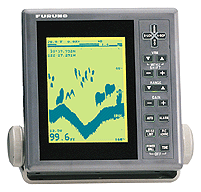|
Using The Fish Finder
Depth finders are a very important tool when fishing. They are
used for locating bottom structure and fish. Learning how to use one
correctly will improve your fishing skills and catching ability to
another level. I can not go  fishing without a sonar unit, itís
like going with out a rod and reel. I will discuss the different
kinds of depth finders and help you find the right one for you.
Depth finders will show you the depth of the water, trees, rocks,
fish, bait and thermo cline ( where the most oxygen is). I use my
depth finder like a set of eyes, I can tell what is going on at all
times below me. What ever kind of fish you are trying to catch, a
sonar unit will help you understand and catch more fish. There
are a
lot of different brands and models on the market. Most units will
have four to six hundred watts of power peak to peak, the stronger
models will have three thousand watts peak to peak. The pixel count
is very important to have a clear picture, the more expensive models
have 240x240 and the less expensive ones have 160x160. Most sonar
units are called LCR, which are liquid crystal units and are gas
sealed to make them waterproof. The way sonar works is a electrical
pulse converted into a sound wave by the transducer and transmitted
into the water. When this wave strikes an object, it is reflected.
Since the speed of sound through water is known, the time lapse
between the transmitted signal and the received echo can be measured
and the distance to the object determined. fishing without a sonar unit, itís
like going with out a rod and reel. I will discuss the different
kinds of depth finders and help you find the right one for you.
Depth finders will show you the depth of the water, trees, rocks,
fish, bait and thermo cline ( where the most oxygen is). I use my
depth finder like a set of eyes, I can tell what is going on at all
times below me. What ever kind of fish you are trying to catch, a
sonar unit will help you understand and catch more fish. There
are a
lot of different brands and models on the market. Most units will
have four to six hundred watts of power peak to peak, the stronger
models will have three thousand watts peak to peak. The pixel count
is very important to have a clear picture, the more expensive models
have 240x240 and the less expensive ones have 160x160. Most sonar
units are called LCR, which are liquid crystal units and are gas
sealed to make them waterproof. The way sonar works is a electrical
pulse converted into a sound wave by the transducer and transmitted
into the water. When this wave strikes an object, it is reflected.
Since the speed of sound through water is known, the time lapse
between the transmitted signal and the received echo can be measured
and the distance to the object determined.
Picking a sonar unit depends on the depth of water you will be
fishing most of the time. Most units on the market will use a
20degree, 192 khz transducer cone, which will work best for most
fishing . When you are fishing at depths of more than two hundred
feet, a narrow 8degree cone transducer will work better. In 15 feet
of water a 20degree transducer covers an area of the bottom thatís
about 6 feet across. An 8 degree transducer covers only about a 2
foot circle. The narrower cone transducers are for deep water
fishing, like salt water fishing. If you are using a 20degree
transducer in 250 feet of water, the cone angle is so wide when it
hits the bottom the echo will not make it back to the transducer therefore
you wonít see any objects between you and the bottom.
There are other sonar units that have multiple transducers and some
with side viewing .
I will go over the most important settings on your sonar unit.
First is the sensitivity control which is the most important to have
set right, it should be at least 75 percent to full. The gray line,
6 to 12 percent or turn it off and start to increase until you get a
gray bottom separation. The chart speed should always be on as fast
as it will go, remember the slower the boat speed the faster the
chart speed and the faster the boat speed the slower the chart
speed. Turn the suppressor off, this is used to reduce interference
from noise. If you turn it up to high you will suppress the signal
and wonít see anything.
When fishing in a river with a lot of current it is better to
graph going with the current. I have found going with the current,
the fish donít spook as bad. Lake fishing it doesnít seem to
matter. After fishing for awhile and using a sonar unit, you should
be able to tell what kind of structure your fishing.
|
|